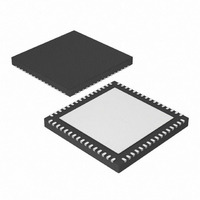DSPIC33FJ128GP206A-I/MR Microchip Technology, DSPIC33FJ128GP206A-I/MR Datasheet - Page 203

DSPIC33FJ128GP206A-I/MR
Manufacturer Part Number
DSPIC33FJ128GP206A-I/MR
Description
IC DSPIC MCU/DSP 128K 64-QFN
Manufacturer
Microchip Technology
Series
dsPIC™ 33Fr
Datasheet
1.DSPIC33FJ64GP206A-IMR.pdf
(338 pages)
Specifications of DSPIC33FJ128GP206A-I/MR
Core Processor
dsPIC
Core Size
16-Bit
Speed
40 MIPs
Connectivity
I²C, IrDA, LIN, SPI, UART/USART
Peripherals
AC'97, Brown-out Detect/Reset, DMA, I²S, POR, PWM, WDT
Number Of I /o
53
Program Memory Size
128KB (128K x 8)
Program Memory Type
FLASH
Ram Size
8K x 8
Voltage - Supply (vcc/vdd)
3 V ~ 3.6 V
Data Converters
A/D 18x10b/12b
Oscillator Type
Internal
Operating Temperature
-40°C ~ 85°C
Package / Case
64-VFQFN, Exposed Pad
Product
DSCs
Processor Series
DSPIC33F
Core
dsPIC
3rd Party Development Tools
52713-733, 52714-737, 53276-922, EWDSPIC
Development Tools By Supplier
PG164130, DV164035, DV244005, DV164005, PG164120, DM240001, DV164033
Lead Free Status / RoHS Status
Lead free / RoHS Compliant
Eeprom Size
-
Lead Free Status / Rohs Status
Lead free / RoHS Compliant
- Current page: 203 of 338
- Download datasheet (3Mb)
19.3
The CAN module can operate in one of several operation
modes selected by the user. These modes include:
• Initialization Mode
• Disable Mode
• Normal Operation Mode
• Listen Only Mode
• Listen All Messages Mode
• Loopback Mode
Modes are requested by setting the REQOP<2:0> bits
(CiCTRL1<10:8>). Entry into a mode is Acknowledged
by
(CiCTRL1<7:5>). The module will not change the mode
and the OPMODE bits until a change in mode is
acceptable, generally during bus Idle time, which is
defined as at least 11 consecutive recessive bits.
19.3.1
In the Initialization mode, the module will not transmit or
receive. The error counters are cleared and the
interrupt flags remain unchanged. The programmer will
have access to Configuration registers that are access
restricted in other modes. The module will protect the
user from accidentally violating the CAN protocol
through programming errors. All registers which control
the configuration of the module can not be modified
while the module is on-line. The CAN module will not
be allowed to enter the Configuration mode while a
transmission is taking place. The Configuration mode
serves as a lock to protect the following registers:
• All Module Control Registers
• Baud Rate and Interrupt Configuration Registers
• Bus Timing Registers
• Identifier Acceptance Filter Registers
• Identifier Acceptance Mask Registers
19.3.2
In Disable mode, the module will not transmit or
receive. The module has the ability to set the WAKIF bit
due to bus activity, however, any pending interrupts will
remain and the error counters will retain their value.
If the REQOP<2:0> bits (CiCTRL1<10:8>) = 001, the
module will enter the Module Disable mode. If the module
is active, the module will wait for 11 recessive bits on the
CAN bus, detect that condition as an Idle bus, then
accept the module disable command. When the
OPMODE<2:0>
indicates whether the module successfully went into
Module Disable mode. The I/O pins will revert to normal
I/O function when the module is in the Module Disable
mode.
The module can be programmed to apply a low-pass
filter function to the CiRX input line while the module or
the CPU is in Sleep mode. The WAKFIL bit
(CiCFG2<14>) enables or disables the filter.
2009 Microchip Technology Inc.
monitoring
Modes of Operation
INITIALIZATION MODE
DISABLE MODE
bits
the
(CiCTRL1<7:5>) = 001,
dsPIC33FJXXXGPX06A/X08A/X10A
OPMODE<2:0>
that
Preliminary
bits
19.3.3
Normal
REQOP<2:0> = 000. In this mode, the module is
activated and the I/O pins will assume the CAN bus
functions. The module will transmit and receive CAN
bus messages via the CiTX and CiRX pins.
19.3.4
If the Listen Only mode is activated, the module on the
CAN bus is passive. The transmitter buffers revert to
the port I/O function. The receive pins remain inputs.
For the receiver, no error flags or Acknowledge signals
are sent. The error counters are deactivated in this
state. The Listen Only mode can be used for detecting
the baud rate on the CAN bus. To use this, it is
necessary that there are at least two further nodes that
communicate with each other.
19.3.5
The module can be set to ignore all errors and receive
any message. The Listen All Messages mode is
activated by setting REQOP<2:0> = ‘111’. In this
mode, the data which is in the message assembly buf-
fer, until the time an error occurred, is copied in the
receive buffer and can be read via the CPU interface.
19.3.6
If the Loopback mode is activated, the module will
connect the internal transmit signal to the internal
receive signal at the module boundary. The transmit
and receive pins revert to their port I/O function.
Note:
Operation
Typically, if the CAN module is allowed to
transmit in a particular mode of operation
and
immediately after the CAN module has
been placed in that mode of operation, the
module waits for 11 consecutive recessive
bits
transmission. If the user switches to
Disable mode within this 11-bit period, then
this transmission is aborted and the corre-
sponding TXABT bit is set and TXREQ bit
is cleared.
NORMAL OPERATION MODE
LISTEN ONLY MODE
LISTEN ALL MESSAGES MODE
LOOPBACK MODE
on
a
transmission
mode
the
bus
is
DS70593B-page 203
before
selected
is
requested
starting
when
Related parts for DSPIC33FJ128GP206A-I/MR
Image
Part Number
Description
Manufacturer
Datasheet
Request
R

Part Number:
Description:
Manufacturer:
Microchip Technology Inc.
Datasheet:

Part Number:
Description:
Manufacturer:
Microchip Technology Inc.
Datasheet:

Part Number:
Description:
Manufacturer:
Microchip Technology Inc.
Datasheet:

Part Number:
Description:
Manufacturer:
Microchip Technology Inc.
Datasheet:

Part Number:
Description:
Manufacturer:
Microchip Technology Inc.
Datasheet:

Part Number:
Description:
Manufacturer:
Microchip Technology Inc.
Datasheet:

Part Number:
Description:
Manufacturer:
Microchip Technology Inc.
Datasheet:

Part Number:
Description:
Manufacturer:
Microchip Technology Inc.
Datasheet:










